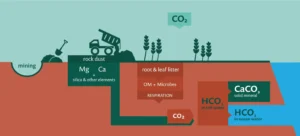GS3 – Environment

Context:
ERW is emerging as a viable method for carbon sequestration by spreading crushed rock over agricultural lands to accelerate natural weathering.
Mechanism of ERW:
- Carbon Capture Process:
- CO₂ from air or soil dissolves in rainwater, forming carbonic acid.
- This reacts with rocks, breaking down minerals and storing carbon as bicarbonate, which may convert to limestone.
- Method:
- Finely ground, fast-weathering rocks like basalt are spread over farmland to increase the surface area for chemical reactions, enhancing CO₂ absorption.
Advantages:
- Soil Fertility Enhancement:
- Increases alkalinity and nutrient availability, boosting crop productivity.
- Cost Efficiency:
- Basalt is abundant and often a byproduct of quarrying, making the process economical.
- Environmental Benefits:
- Can neutralise acidic runoff, preventing ocean acidification and indirect CO₂ emissions.
Challenges and Risks:
- Heavy Metal Contamination:
- Some rocks may contain toxic elements like nickel or chromium.
- Health Hazards:
- Inhalation of fine rock dust poses respiratory risks without adequate safety gear.
- Carbon Accounting Concerns:
- Overestimating CO₂ capture could result in misleading emission offsets.
Global Developments:
- Brazil: Issued the first verified ERW carbon removal credits in the world.
- India: Mati Carbon, an Indian ERW startup, won the $50 million XPRIZE Carbon Removal award.




